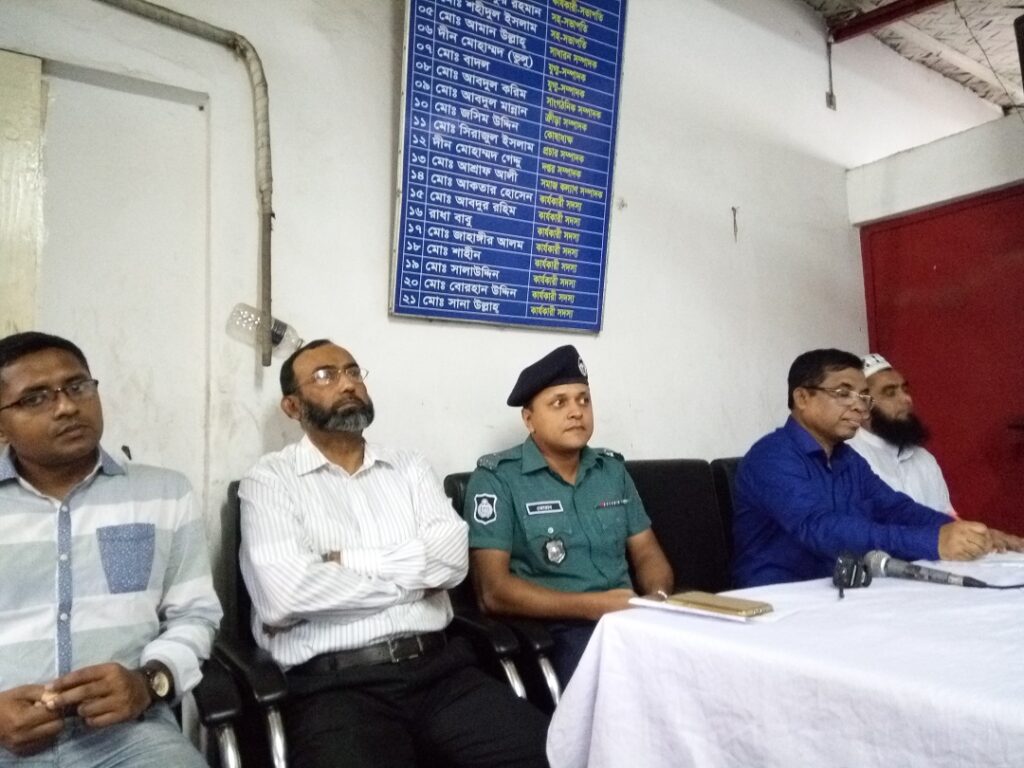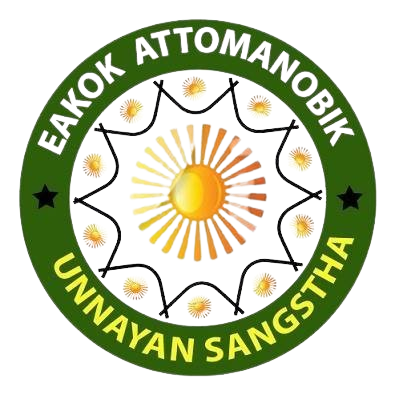
EAKOK ATTOMANOBIK UNNAYAN SANGSTHA
Sustainable Futures with EAKOK
- FULL NAME OF PROJECT
ROAD SAFETY AWARENESS PROGRAM
- Project Areas : Countrywide
- Start Date: 15/10/2016
- End date: to till date
- NAME OF DONOR
Global Alliance NGO For Road Safety Switzerland
United Trust (a charity initiative of United Group, Bangladesh)
Introduction to Road Safety Initiatives of Eakok
Recognizing the urgent need to address the increasing number of road accidents in Bangladesh, the organization launched a comprehensive road safety program in October 2016, with initial funding and support from United Trust, the philanthropic wing of United Group, Bangladesh. The early phase of the program focused on skill enhancement and awareness-building among professional drivers to prevent accidents on the roads.
Since 2018, with support from the Global Alliance of NGOs for Road Safety (Switzerland), Eakok Attomanobik Unnayan Sangstha expanded its scope to include road safety audits, advocacy for speed management, and campaigns aligned with international road safety movements such as “Streets for Life” and “Love30.” The organization has also been actively involved in observing national and international road safety days and conducting training sessions for transport workers and students
One of the notable aspects of the organization’s work is the development of a nationwide volunteer network for accident data collection. Since January 2023, around 300 trained volunteers have been collecting and preserving primary data on road accidents across the country. This effort aims to identify the root causes of accidents and support the government in developing targeted road safety policies. As a result of this initiative, the Bangladesh Road Transport Authority (BRTA) formally recognized and enlisted the organization in 2023 to assist in compiling national road accident statistics.
Through its continuous and multi-dimensional efforts, Eakok Attomanobik Unnayan Sangstha remains committed to creating safer roads in Bangladesh and contributing meaningfully to national and global road safety agendas.
Vision & Mission
Vision: To ensure safe mobility for all through community engagement, evidence-based advocacy, and partnerships that promote sustainable road infrastructure and behavior change.
Mission: To reduce road traffic fatalities and injuries in Bangladesh through education, enforcement, engineering solutions, and strong stakeholder collaboration.
Strategic Road Safety Activities (2016–2024)
Over the past years, Eakok has implemented several innovative and evidence-based road safety programs funded by:
– Global Alliance of NGOs for Road Safety (Switzerland)
– United Trust (a charity initiative of United Group, Bangladesh)
Partnerships and Collaboration
Eakok believes in collective action and has actively collaborated with:
- Global Alliance of NGOs for Road Safety
- United Trust.
- Bangladesh Road Transport Authority (BRTA)
- Road and Highway (RHD)
- Accident Research Institute (ARI)
- Highway Police Unite.
- Local Traffic Police Units.
- Educational Institutions.
- Health Professionals.
- Local Government Bodies
Key Initiatives Include:
- Commit To Act 2024 – Mobility Snapshots.
- Road Crash Data Analysis (RCDA) Project.
- Streets for Life & #Love30 Campaign.
- School Zone Road Safety Assessment & Improvement (using iRAP Method).
- UN Global Road Safety Week Celebrations.
- Speed Management & Advocacy for School Zones.
- Awareness Training for Transport Drivers.
- Free Health Camps for Drivers and Transport Workers.
- Student Awareness Workshops on Road Accidents
Implemented Road Safety Activities:
- FULL NAME OF PROJECT
Commit To Act Mobility
- Project Areas : GULSHAN -1 & GULSHAN -2 INTERSECTION
- Start Date: 01/08/2024
- End date: 31/10/2024
- NAME OF PARTNER
Global Alliance NGO For Road Safety Switzerland
United Trust (a charity initiative of United Group, Bangladesh)
OBJECTIVES OF THE PROGRAM
Through this program, an on-site observation was conducted at Gulshan-1 and Gulshan-2 intersections in Dhaka to assess the challenges faced by pedestrians while crossing the roads.
The study examined the experiences of pedestrians, the impact of excessive vehicle pressure and speed on timely road crossing, and whether traffic signals make crossing more difficult.
It also analyzed the types of vehicles present, the influence of rain and adverse weather conditions, and the obstacles faced by children and the elderly, who generally cross at a slower pace.
Additionally, the safety measures in place for pedestrian crossings were evaluated. Interviews and consultations were conducted with pedestrians and local representatives to gather their insights and recommendations. Based on the on-site observations, interviews with pedestrians and local representatives, and their feedback, the current status of this location will be assessed against international standards. In light of these standards, expert opinions, along with a designed framework, will be presented to the relevant authorities to ensure enhanced protection and safety measures for pedestrians at this location.
- NAME OF PROGRAM
Streets for Life & Love30 Campaign
- Project Areas : Dhaka district
- Start Date: 15/05/2023
- End date: 14/07/2023
- NAME OF PARTNER
Global Alliance NGO For Road Safety Switzerland
Objectives of the Program |
The objective of the project is to promote road safety by limiting vehicle speed to 30 km/h in critical areas such as residential zones, busy city centers, schools, and hospitals, while ensuring safe and uninterrupted pedestrian movement. This will be achieved through targeted awareness campaigns, including roadshows, roundtable discussions, and community/social media engagements.
Under this program the following activities has be done:- a) Advocacy program for demarcation of residential and education areas as 30 km zone. b) In residential area of Dhaka City Corporation on a particular day of the week declared as Car Free Day. c) Creating opportunities for children to play sports on certain roads in residential areas of the city on car-free days d) Installation of 30km/h speed sign in areas adjacent to educational institutions. e) Establishing bicycle lanes on city streets. f) Celebrated UN Global Road Safety Week-2023.
|
Achievement/Result of the Advocacy Success: Urban Speed Limit Policy Reform |
Eakok’s sustained advocacy efforts culminated in a significant policy achievement: the formal adoption of the Motor Vehicle Speed Limit Guideline-2024, which mandates a 30 km/h speed limit in urban areas across Bangladesh. This landmark decision represents a major victory in the pursuit of safer streets and reflects the organization’s long-standing commitment to promoting road safety through evidence-based advocacy.
Since 2019, Eakok has engaged in strategic, community-centered advocacy by organizing roadshows, public awareness campaigns, street meetings, and national-level seminars. These efforts helped raise public consciousness about the dangers of high-speed driving in densely populated areas and the benefits of safer speed limits. Through inclusive engagement, Eakok successfully mobilized public opinion and generated pressure on policymakers to take action. The culmination of these efforts was the approval of the Motor Vehicle Speed Limit Guideline-2024 by the Road Transport and Highways Division on May 5, 2024, with the new speed limit officially coming into effect on May 8, 2024. This policy reform demonstrates the impact of grassroots mobilization in shaping national-level decisions, showing how civil society organizations can play a critical role in public policy development. The reform is a transformative step toward ensuring safer urban mobility, especially for vulnerable populations such as pedestrians, children, and the elderly. Eakok’s success not only improves safety outcomes on Bangladesh’s roads but also aligns national transport policy with international standards, including the UN and WHO’s “Streets for Life” initiative. This achievement stands as a powerful example of how persistent, community-driven advocacy can lead to meaningful and lasting policy change. |
A SPECIFIC ROAD IN JAHURI MOHALLA OF DHAKA NORTH CITY CORPORATION IS DESIGNATED AS CAR-FREE ON A PARTICULAR DAY OF THE WEEK, ALLOWING CHILDREN FOR PLAYING.
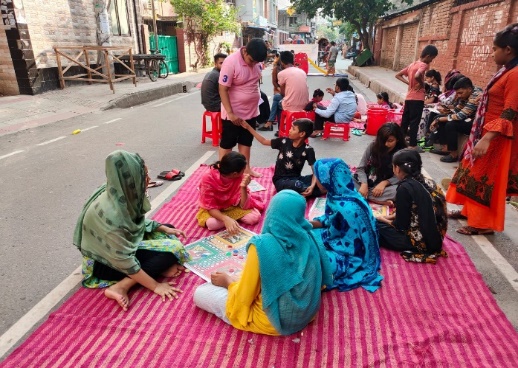
30 KM/H SPEED LIMIT CAMPAIGN IN EDUCATIONAL INSTITUTIONS AND URBAN AREAS
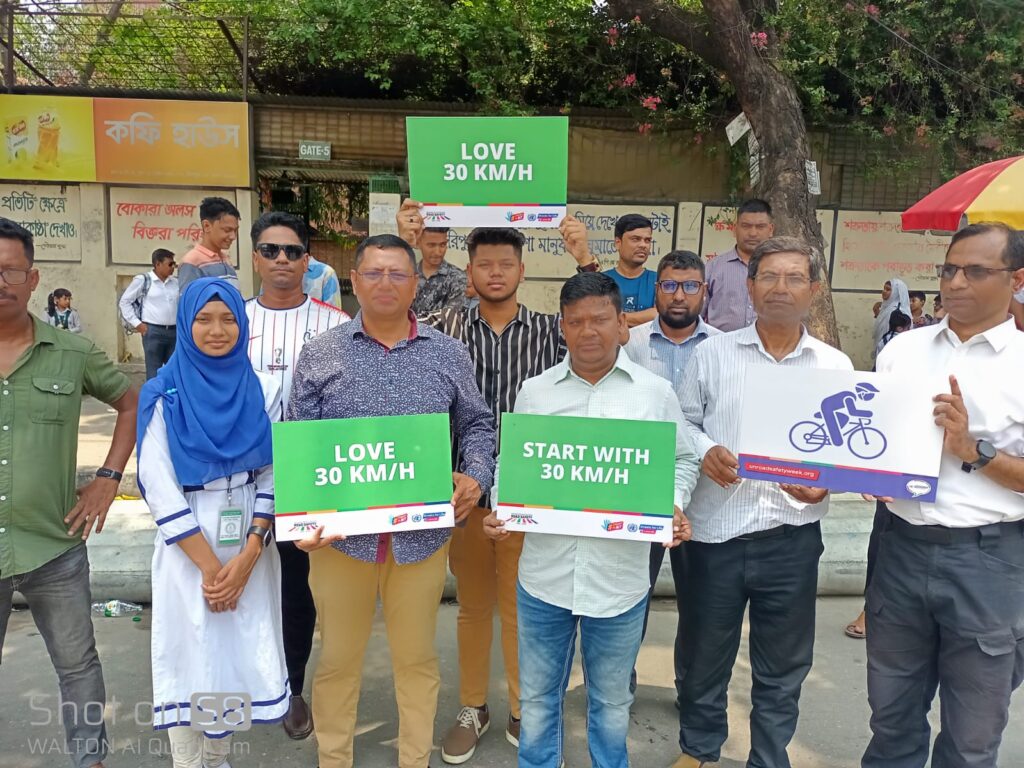
- NAME OF PROGRAM
School zone road safety assessment and improvement program under iRAP methods
- Project Areas : Dhaka-Aricha Dhaka-Chittagong Dhaka – Sylhet Highway
- Start Date: 15/05/2023
- End date: 14/07/2023
- NAME OF PARTNER
Global Alliance NGO For Road Safety Switzerland
Under this project, a total of 10 educational institutions located along the busiest national highways in Bangladesh are assessed for accident risks in their respective school zone areas through comprehensive Road Safety Audits. The project carries out multiple advocacy and capacity-building activities focused on effective speed limit management. As a result, infrastructural safety improvements within the school zones of these 10 institutions are actively advocated to reduce road crash risks and ensure safer mobility for students and surrounding communities.
The targeted Institutions are:
- Gonoshasthaya Samaj Vittik Medical College, Dhaka – Aricha Hwy, Savar, Dhaka.
- Radio Colony Model School, Dhaka – Aricha Hwy Savar, Dhaka.
- Shibalaya Government High School, Aricha Hwy, Shivalaya, Manikganj.
- Bongail Gopal Chandra High School, Dhaka – Aricha Hwy, Shibaloy, Manikganj.
- Jagir High School Dhaka Aricha Hyw, Manikganj.
- US-Bangla Medical College Hospital, Dhaka-Sylhet Highway, Tarabo, Narayangonj.
- Abdul Kader Mollah City College at Dhaka-Sylhet Highway, Narshingdi,
- Gouripur Munshi Fazlur Rahman Govt. Degree College Dhaka – Chittagong Hwy, Comilla.
- Hasanpur Shahid Nazrul Government Degree College, Dhaka – Chittagong Hwy, Daudkandi, Comilla.
- Bara Gobindapur AMB High School, Dhaka – Chittagong Hwy, Chandina, Comilla.
The following data is collected during the road safety audit of school zone areas:
- Speed measurements within the school zones
- Traffic flow and vehicle mix
- Traffic crash data
- Records of speeding offences from the police
- Design speed and criteria used during construction or rehabilitation of the road
- Surrounding land use and property access adjacent to the road
- Physical characteristics of the road and its roadside environment
- Presence of vulnerable road users (e.g., children, pedestrians, cyclists)
Apart from this, 10 local level advocacy workshops, 01 high level policy making workshop
and 2 UN Global Road Safety Week campaigns organized in 2021 and 2022.
IMAGE OF ROAD SAFETY AUDIT TEAM
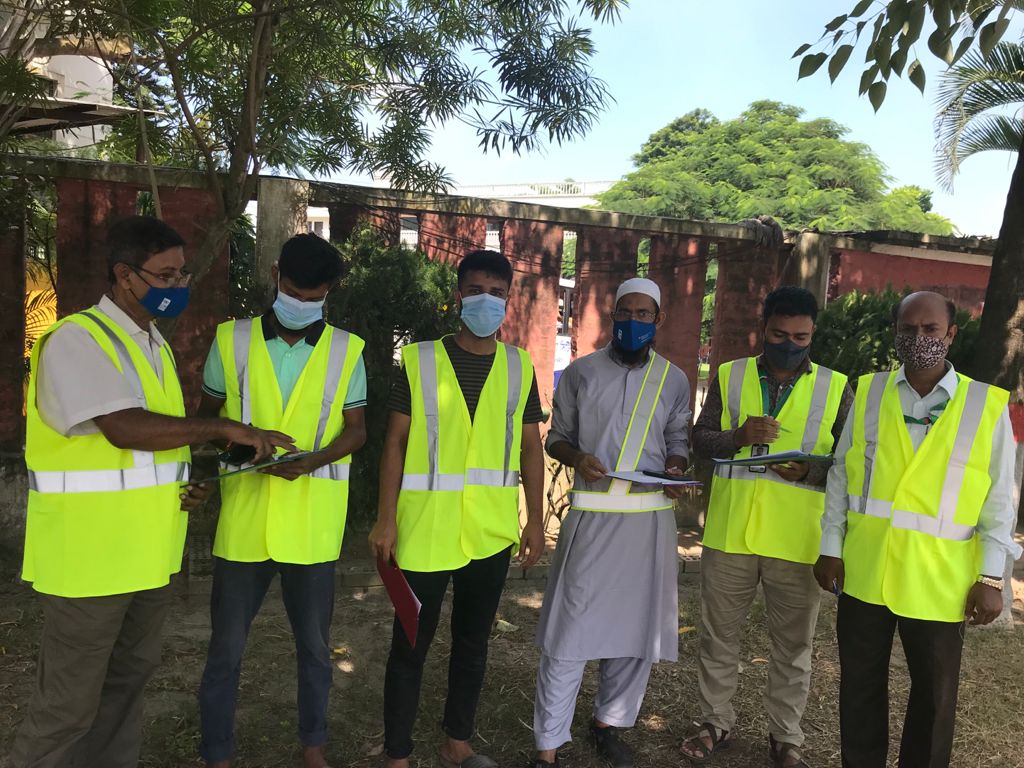
IMAGE OF ROAD SAFETY AUDIT
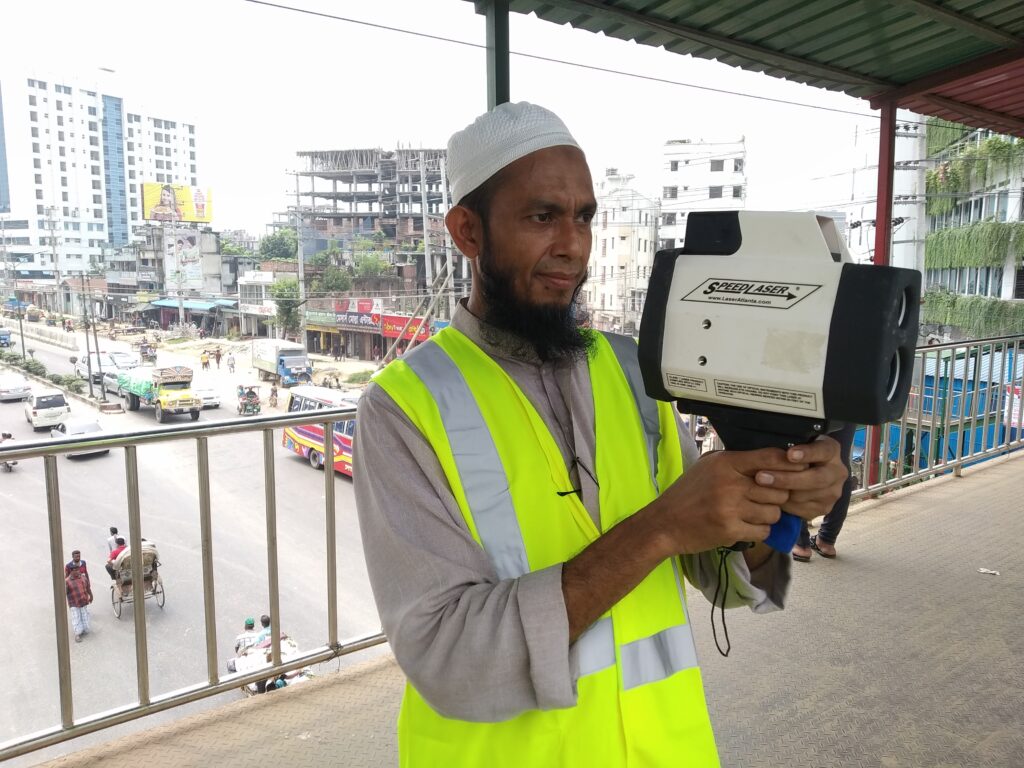
LOCAL LEVEL ADVOCACY WORKSHOPS
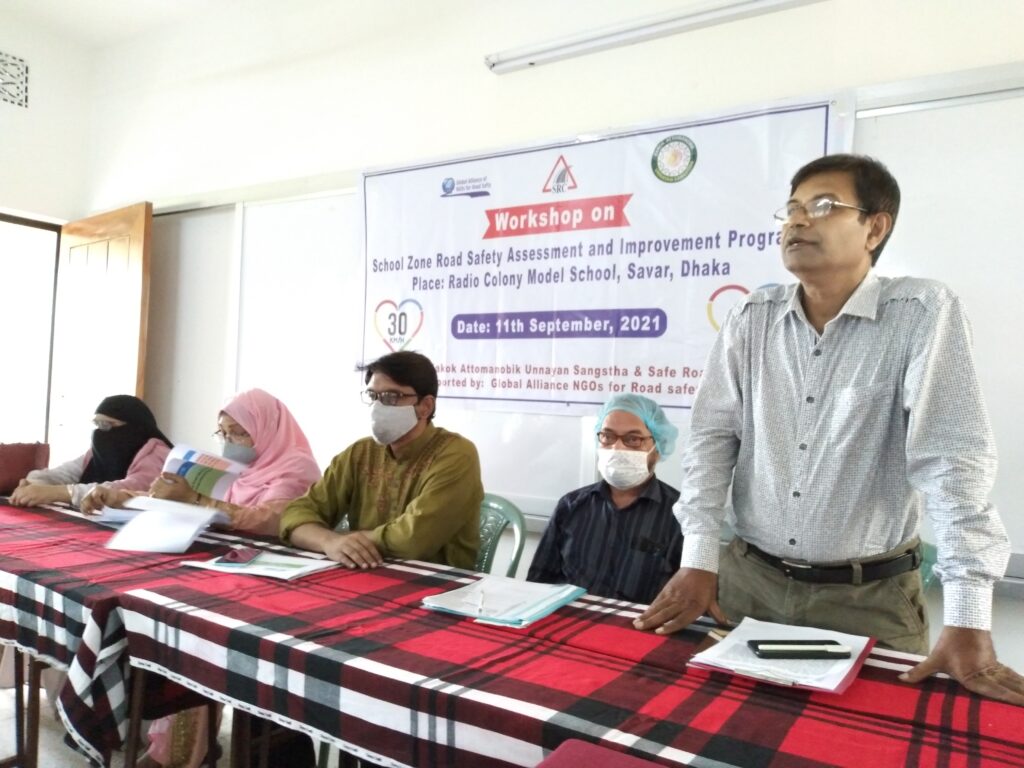
HIGH LEVEL POLICY MAKING WORKSHOP
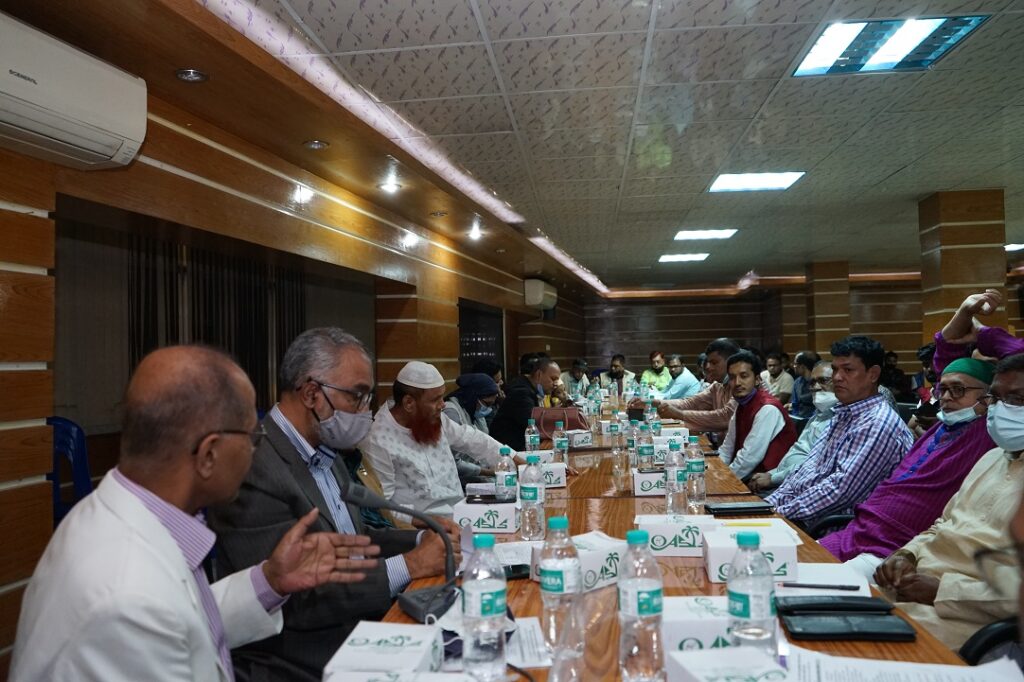
- NAME OF PROGRAM
Speed Management & Advocacy Activities for Infrastructural Improvement in the School Zone Areas
- Project Areas : AMINBAZAR, DHAKA-ARICHA HIGHWAY
- Start Date: 10/12/2018
- End date: 15/02/2019
- NAME OF PARTNER
Global Alliance NGO For Road Safety Switzerland
As part of the project, baseline data on school zone road safety was collected using a combination of focus group discussions (FGDs), key informant interviews (KIIs), direct observation, and the iRAP School Assessment methodology. The primary objective was to evaluate the existing safety conditions and to develop an advocacy plan aimed at improving the school zones to achieve a minimum 3-star iRAP safety rating by November 2019. Under the iRAP assessment, two schools were selected based on their high-risk locations along the Dhaka-Aricha Highway, one of the busiest national highways in the country. The selected schools are:
Both schools are situated in very close proximity to the highway, exposing students to significant traffic hazards. Mirpur Government Primary School, in particular, serves students from classes one to five and is one of the oldest public schools in the area. The majority of the students come from low-income families, and many of them walk to school alone due to the unavailability of parents to accompany them. The location of the school is highly unsafe. There are no footpaths, pedestrian crossings, road signs, or traffic signals in the vicinity of the school. These critical infrastructure gaps put children at severe risk while accessing their school. As a result of the iRAP assessment, Mirpur Government Primary School received a 1-star safety rating, which indicates a very high-risk environment for pedestrians, particularly children. The findings underscore the urgent need for targeted advocacy and infrastructural interventions to upgrade the safety level of the school zone to at least a 3-star rating, ensuring safer access and mobility for students. |
Road Safety Assessment Report |
This report outlines the critical road safety issues identified in front of Mirpur Government Primary School, and Mofid-E-Um School and College situated adjacent to the Dhaka-Aricha Highway. The school’s proximity to one of the country’s busiest highways, combined with a lack of basic road safety infrastructure, presents a serious threat to the safety and well-being of its students—many of whom commute alone on foot. Key Findings:
There is no traffic or warning sign installed in front of the school to alert drivers about the presence of children or a school zone.
Footpaths, where present, are in dilapidated and raw condition. They are unprotected and often occupied by car parking, motorcycle (Honda) parking, and mobile shops, leaving no safe walking space for children.
There are no protective railings or barriers along the roadside to guide or safeguard children walking to school.
The road lacks any form of speed control measures, such as speed bumps, rumble strips, or school zone speed limit signs, resulting in high-speed vehicle movement directly in front of the school.
There is no zebra crossing, foot over bridge, or underpass near the school, forcing children to cross the busy highway at great personal risk.
During school hours, no school staff or volunteers are deployed to assist students in safely crossing the road. The school authority has not taken any proactive measures to ensure student safety during arrival and departure times. Recommendations: The current condition of the school’s surroundings poses a severe risk to student safety. Immediate and coordinated interventions are essential, including:
A comprehensive road safety improvement plan is urgently needed to ensure that students can access education without risking their lives |
Based on the above findings, a follow-up workshop was organized to address the safety concerns of these schools. The workshop was attended by parents, local public representatives, teachers from both schools, the Additional Chief Engineer of Road & Highway, Road Design Engineer of Road & Highway and the Additional Police Commissioner (Traffic). In the workshop, the infrastructure improvement designs required to upgrade the school zone to a 3-star rating were also presented.
In the workshop, the Roads and Highways Department assured that necessary actions would be taken soon based on the recommendations and designs, and subsequently, actions were indeed taken.
Image of the front of the Schools
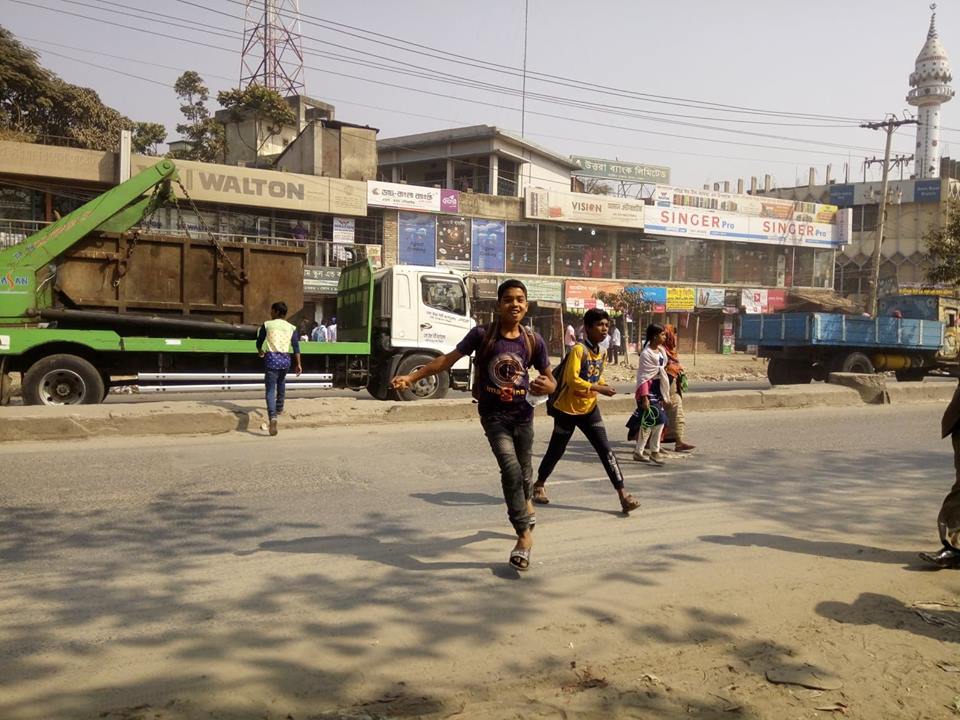
IMAGE OF THE WORKSHOP
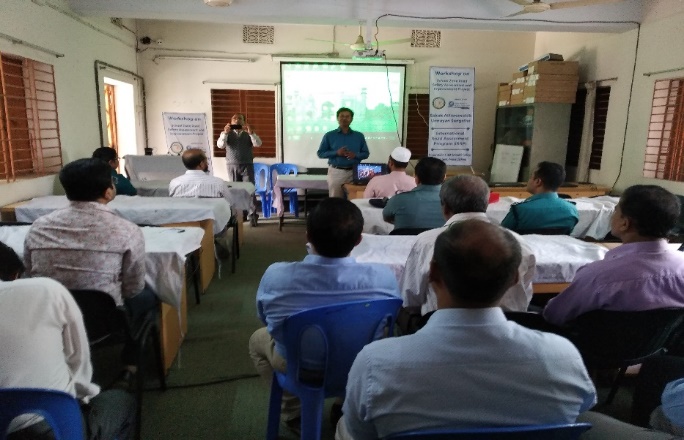
LOCATION IMAGE ONE YEAR LATER
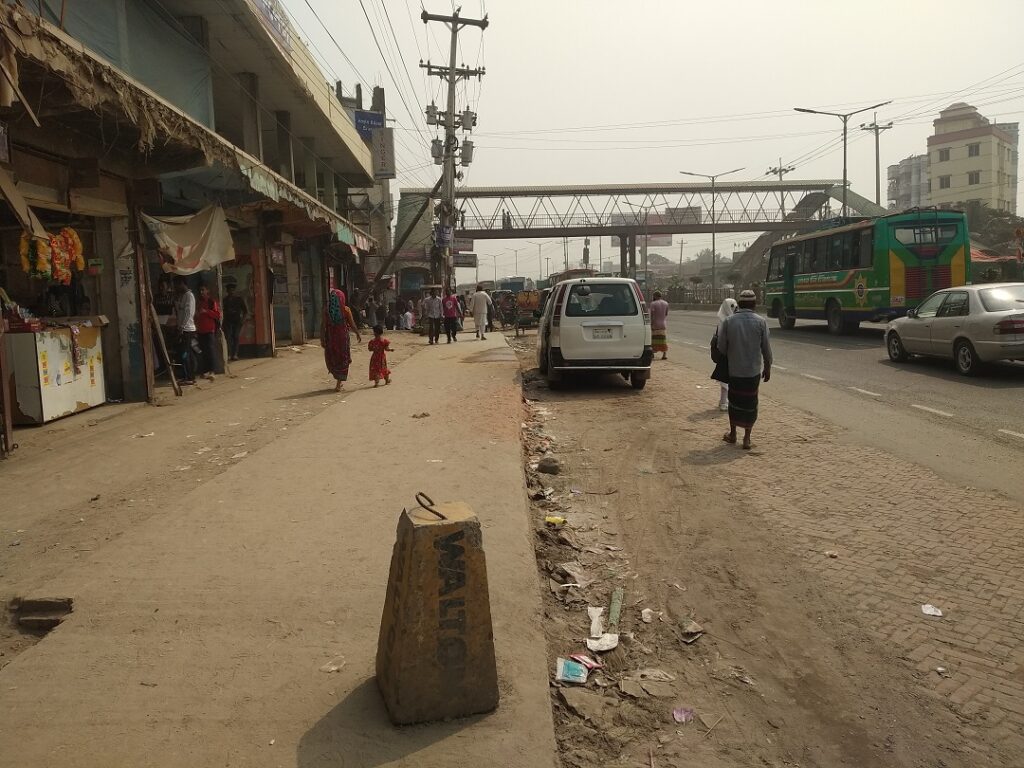
Newspapper
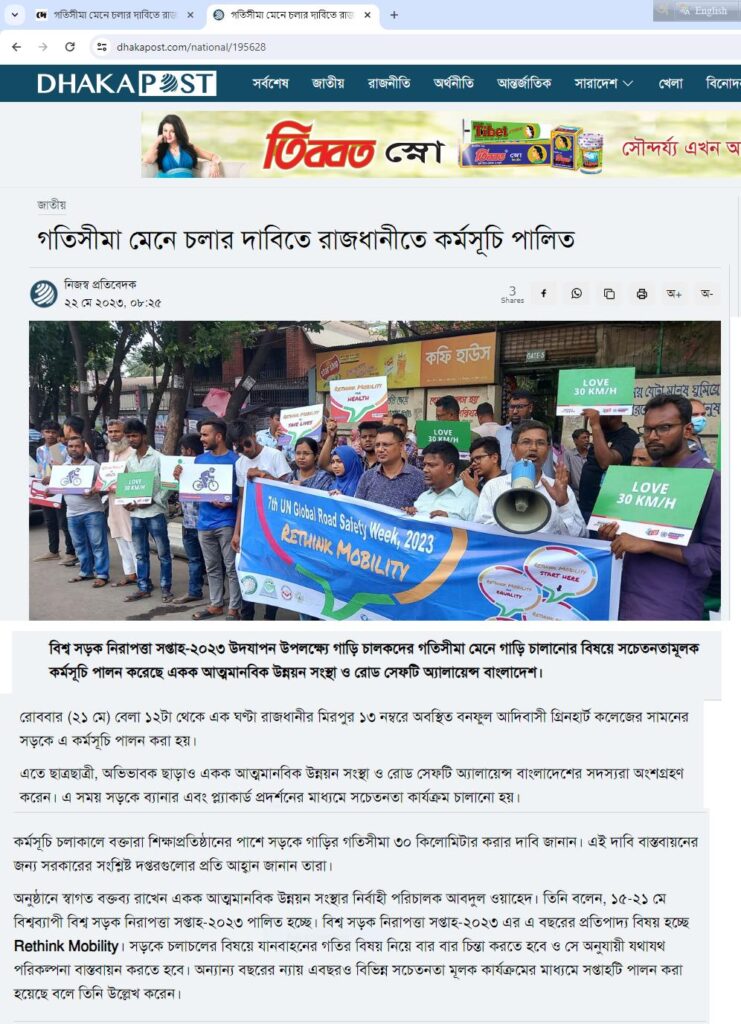
- NAME OF PROGRAM
Road safety Awareness for Transport Workers & Drivers
- Project Areas : All Over the country
- Start Date: 18/10/2016
- End date: 19/12/2019
- NAME OF PARTNER
United Trust
Under this program, a total of 3,444 transport workers and professional drivers were provided with awareness-based training in 25 batches to systematically reduce road accidents. Retired Brigadier General A.J.M. Fazlur Rahman, Executive Director of United Trust, provided continuous support and guidance by being actively present throughout the entire program. In addition The local BRTA, local traffic department, and highway police provided full support in this program. |
Objective and Purpose of the Program: |
Goal: To reduce the rate of road accidents and ensure a safer road transport system. Objectives:
|
List of Training Team Members for This Program: |
1. Mr. Zakir Hossain, Additional Chief Engineer, Road & Highway. 2. Md. Habibur Rahman Executive Engineer, Road design & safety circle, Road & Highway. 3. A.B.M. Abubakor Siddiq, Accident Data analyst, BRTA , Dhaka. 4. Kazi Md. Saifun Nawaz, Assistant Professor, Accident Research Institute (ARI) BUET, Dhaka. 5. Md. Saiful Kabir, Vehicle Inspector, BRTA, , Mymensingh. 6. Mr. Nazrul Islam, Vehicle Inspector, BRTA, , Jamalpur. 7. Mr. Shahin Hossain Mollah, Director Driver Training Center, Gazipur. |
Names of Implemented Districts |
4. Jamalpur.
|
Outcome of the Program: |
The training program resulted in several positive outcomes. A total of 3,444 transport workers and professional drivers showed improved awareness of road safety and more responsible driving behavior. Risky practices such as over-speeding and signal violations significantly decreased among participants. The active involvement of United Trust, local BRTA offices, traffic departments, and highway police strengthened institutional collaboration for road safety. The program also had a broader community impact, as trained drivers shared their knowledge with peers, promoting safer driving practices. Initial observations from the implementation districts indicated a reduction in minor road accidents involving trained drivers. Overall, the program successfully contributed to building a safer road transport environment and laid the groundwork for sustainable road safety education. |
Event 1
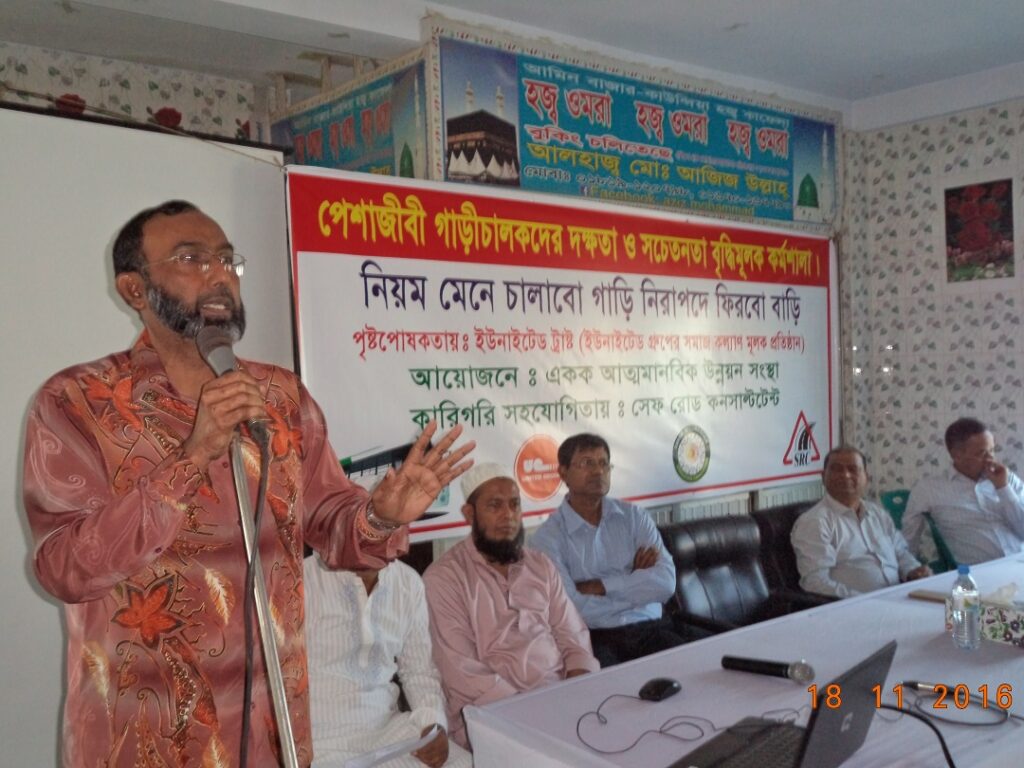
Event 2
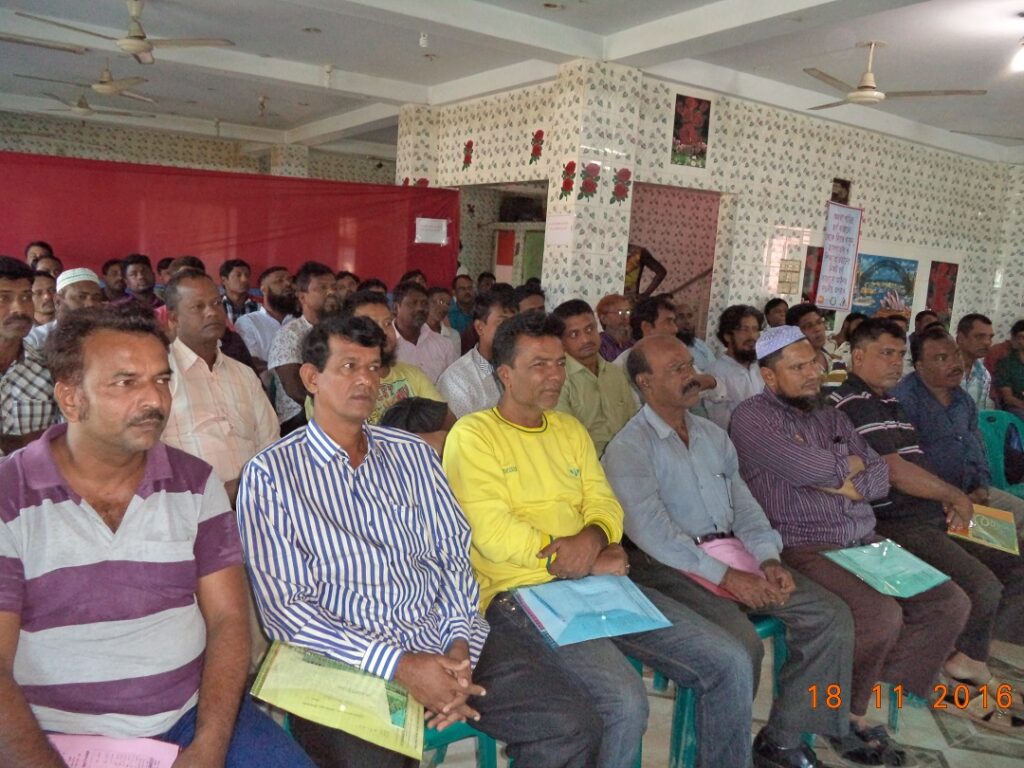
Event 3
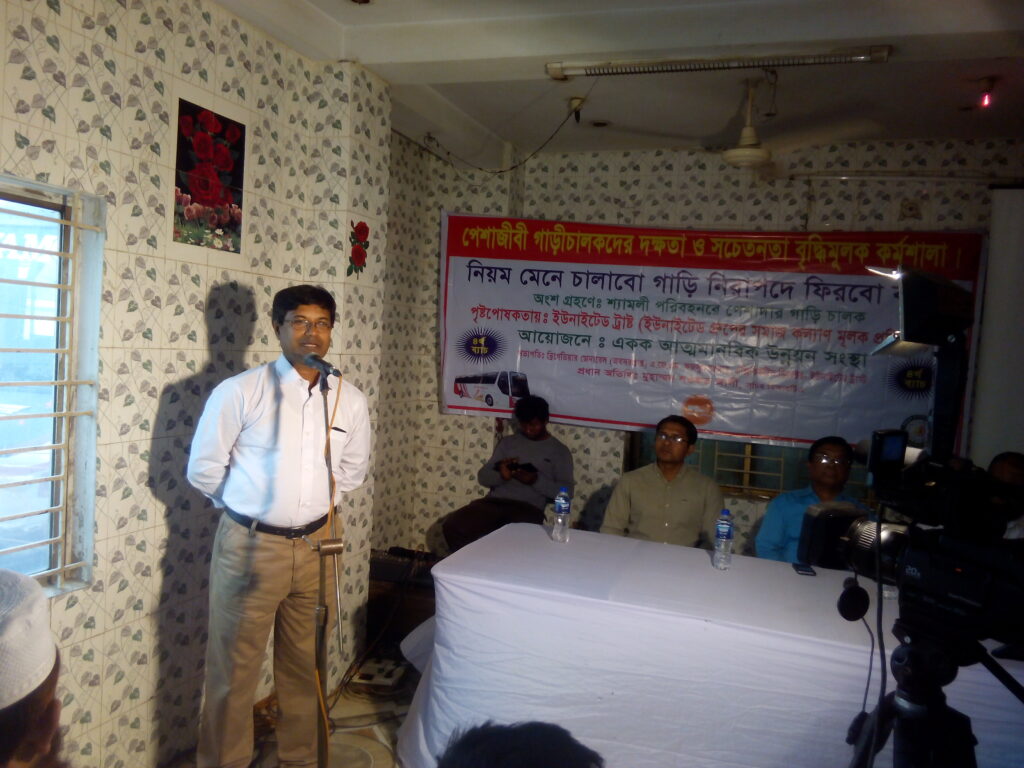
Event 4
